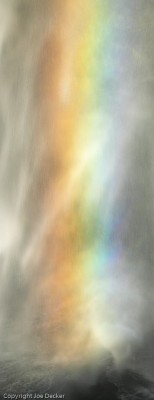
If you like this article, you can now get the book! Joe has expanded the “Tuesday Composition” series into an inspiring new ebook on composition, especially for nature photography. Check it out: The Tuesday Composition.
It is all too easy to forget that when we photograph that we are usually photographing for someone, even if only ourselves. Photography is a type of communication, and the best way to compose a photograph to communicate someone depends on both what you’re trying to communicate and who you are trying to communicate it to. Familiarity is key–if you’re trying to photograph a particular type of animal, if your viewer is likely to be familiar with the animal you’ll want to approach photographing it differently than if they aren’t likely to have seen one before.
It’s helpful to draw an analogy with a dinner party conversation. If you and I are chatting and I start talking about Death Valley, I’ll probably guess that you’ll have heard of Death Valley. I’ll guess that you’ll know it’s a large desert area in California, that it gets very hot there, and perhaps that it has sand dunes. If I start off the conversation by reiterating a bunch of stuff you already know about Death Valley, you’re going to get bored pretty quickly. On the other hand, if I start talking to you about the Aeolian Buttes, I’m probably going to start with an assumption that you know a little less about it, and start with a more basic information.
Of course, when I’m talking to someone, I have the opportunity to adjust this on the fly, if you say “Oh, I love that part of the Mono Basin”, I can move along. But in photography (and writing as well), I don’t have that flexibility. I have to choose up-front how much to say in my photograph, and how much not to say.

If I don’t say enough, I may not actually “get across” whatever it is I want to get across. If I really want to show you how cool the oddly pink Noa Lake is in East Greenland is, a little detail of pink water may be aesthetic, that may be a great piece of art, but if I’m trying to tell you about the lake in general I’m going to have to include the whole lake, the surrounding landscape, mountains and lichen. I’m going to have to establish a sense of scale, I’m going to have to use the other parts of the photograph to help you realize that the pink stuff is pink translucent water and not just a trick of the light.
On the other hand, If I say too much, if I “overexplain” something in a photograph by showing you to much of it and/or by emphasizing it, you may not be insulted but you’ll certainly not be particularly interested.
You know what a waterfall looks like. If I photograph a relatively generic waterfall you might find it pleasing but, unless there’s something really more than “Hey, look a waterfall!” that I’m trying to communicate it’s not going to be something that sticks with you. If there is something interesting about the waterfall, like a nice section of rainbow within it, I can really focus in on it, much as I did in Rainbow Whirlwind, and then even a small section of the waterfall will be more than enough for you to understand the idea of a waterfall without me having to include the whole thing.
There are many ways to photographically indicate an object without really “overexplaining” it–you can simply show a fraction of the object, make a silhouette, perhaps obscure part of the object with other objects–in any case avoiding “overexplaining” can be an important tool for simplifying, and improving your images.